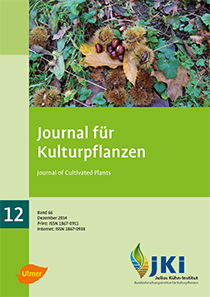Comparative genetic mapping of resistance to fire blight in <em>Malus</em> sp.
Keywords:
Fire blight, Malus, mapping, resistanceAbstract
Four segregating populations were analyzed for comparative mapping of resistance to fire blight in apple. As donors for resistance the Re-cultivar® ‘Rewena’ from the Pillnitz breeding program, M. ×robusta 5 and the accessions of M. baccata and M. fusca were crossed by the susceptible cultivar ‘Idared’.
Phenotyping of resistance in the progeny was done by shoot inoculation using the Erwinia amylovora isolate Ea222 and other defined isolates in greenhouse. The shoot infection was characterized as necrosis rate, the ratio between necrosis length and shoot length. The average necrosis rate varied between 10 to 82% depending on isolate and population. Genotyping was performed with microsatellite-, SNP- and DArT-markers. For the establishment of genetic linkage maps Joinmap 4.0 and for mapping of resistance MapQTL5.0 were used.
Major-QTLs were detected on linkage groups 3, 10 and 12 for M. ×robusta 5, M. fusca and M. baccata, respectively. Whereas the determined major QTLs of M. ×robusta 5 und M. fusca explained up to 87% of the phenotypic variance, depending on year and isolate, the major QTL detected for M. baccata explained only around 45%, which hypothesizes the presence of additional QTLs. No QTL was detected for the resistant cultivar ‘Rewena’.
Based on markers surrounding the detected QTLs a marker assisted selection (MAS) for resistance to fire blight became feasible as well as pyramiding of different QTLs. Pyramiding of differently acting fire blight QTLs shall improve the breeding of durable resistant cultivars in future which will be available for growers.
DOI: 10.5073/JfK.2014.12.02, https://doi.org/10.5073/JfK.2014.12.02
Downloads
Published
Issue
Section
License
The content of the journal is licensed under the Creative Commons Attribution 4.0 License. Any user is free to share and adapt (remix, transform, build upon) the content as long as the original publication is attributed (authors, title, year, journal, issue, pages).
The copyright of the published work remains with the authors. The authors grant the Journal of Cultivated Plants, the Julius Kühn-Institut and the OpenAgrar repository the non-exclusive right to distribute and exploit the work.







